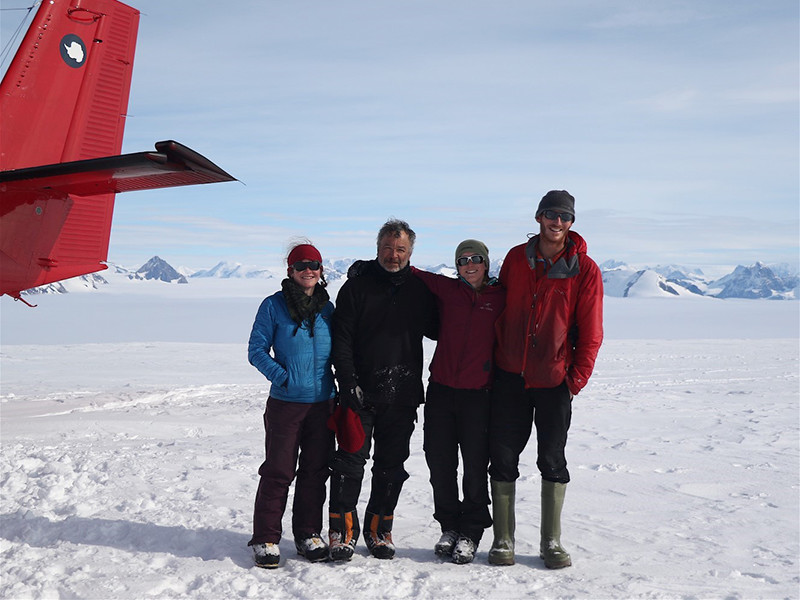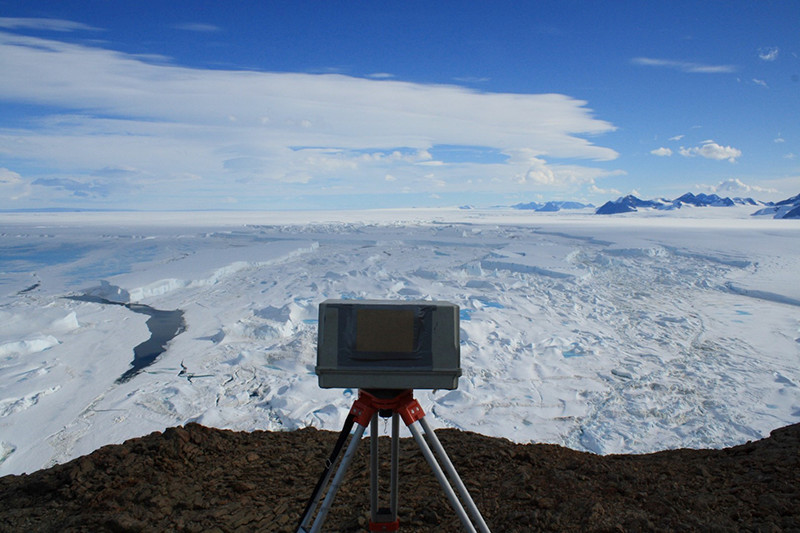Capturing a CollapseScientists hoped to witness the final act of the greatest Antarctic ice shelf disintegration in recent memory.Posted September 27, 2016
Not much remains of the Larsen B Ice Shelf, but what is left can teach scientists a lot about how mighty masses of ice fall apart, especially when its last lingering sliver finally crumbles. Researchers traveled to the Scar Inlet along the Antarctic Peninsula to study the remnants of the former ice shelf in February to better understand the peril that glaciers around Antarctica are facing. Erin Pettit of the University of Alaska, Fairbanks, the project’s lead investigator, and Ted Scambos of the National Snow and Ice Data Center brought with them a slew of instruments to capture what they hoped would be the final breakup of the remaining shelf. “We’re in a great position to really reap a lot of benefit from any further disintegration activity in the Scar Inlet,” Scambos said. 
Photo Credit: Ted Scambos
Devices like this radar array helped the research team capture precise measurements on any changes in the Scar Inlet’s ice conditions.
Though the ice remained intact throughout the warm summer, the team collected a tremendous amount of data about the ice shelves which should yield new insights into how they behave. The research was funded by the National Science Foundation, which manages the U.S. Antarctic Program. The ice that covers the waters of the Scar Inlet along the Antarctic Peninsula is the last substantial fragment of the former Larsen B Ice Shelf. The Rhode Island-sized plate of floating ice fell apart suddenly and dramatically in 2002. During the particularly warm summer, water pooled on the top of the ice shelf, critically weakening it. Over just a matter of weeks, the ice mass, which had remained stable for 12,000 years, completely fell apart. The collapse took scientists completely by surprise, and they quickly focused their attention on the region. Using satellite data, they watched as the glaciers behind the ice shelf started accelerating faster into the ocean after the enormous mass of the ice holding them back disappeared. Since then, the ice shelf in the adjacent Scar Inlet has largely remained intact, but it has undergone changes. 
Photo Credit: Ted Scambos
The research team arrives at the Scar Inlet. (Left to Right) researcher Erin Pettit; researcher Ted Scambos; graduate student Christina Carr; guide Phil ‘Chucky’ Stevens.
“We’ve been watching it for quite a few years and from the satellite imagery, we could see that it was starting to get weaker and weaker and more and more cracked up,” Pettit said. They think that the comparatively thin layer of frozen ocean that abuts the ice shelf has been helping to hold it together. Over the last several years, a layer of frozen ocean a few meters thick formed where the formerly hundred-of-meters-thick Larsen B once was. Called “fast ice” because it holds fast to the shore, this type of sea ice typically breaks apart each year near the end of the summer, but the fast ice in the Scar Inlet has surprised scientists because it has remained intact for about five years and seems to be keeping the hundreds of meter-thick Scar Inlet ice shelf in one piece. “What ended up happening is that there had been, over the last five years, this slow growth of sea ice in front of the ice shelf, Pettit said. “It’s not very thick, but it’s just enough that it was able to stabilize the ice shelf; this is our working hypothesis right now.” However, scientists don’t think this sea ice will be able to buttress the ice shelf forever. They suspect that once the sea ice breaks out, it will lead to the collapse of the Scar Inlet ice shelf and the subsequent acceleration of the glaciers behind it. Catching this breakup of the fast ice and any further collapse of the ice shelf would yield a tremendous amount of information about how these vast tracts of ice fall apart, up-close information that has never been gathered before. This year was a good bet to watch it happen. El Niño in the Pacific brought warmer than usual water temperatures to the region, which the researchers hoped would be just enough to melt the ice and bring about such a collapse. From their vantage point on a nearby hill, the team set up radars, cameras, seismometers and infrasound arrays to capture all of the data they could about both the fast ice and the adjacent ice shelf. “We were set out on a little cape that stuck out right between the areas,” Scambos said. “To the north of us was an area of fast ice that used to be the Larsen B that all broke apart in 2002 and to the south of us was this Scar Inlet ice shelf. We could see the ice front and we could see some of the fast ice that was pushing against the ice front.” Though they didn’t capture the big collapse that they hoped to, they were able to capture data for a number of smaller instances where chunks of ice calved off from the shelf. 
Photo Credit: Ted Scambos
A time-lapse camera records the Scar Inlet, looking for changes in the ice.
“We have a lot of camera data, and that did capture a few events, small compared to the breakup that occurred in 2002, but they were examples of 2002 where a melt pond would drain through a block of ice that was floating on the ocean suddenly, within the space of a day or two,” Scambos said. Should the ice shelf break up, it would mean that there’s nothing holding back the advancing glacier behind it. These glaciers have potentially global impacts because as they advance and plunge into the sea it causes the ocean to rise. Fast ice and ice shelves are already floating on the oceans, so if they break apart it doesn’t directly impact global sea levels, but they’re the brakes that hold back the advancing glaciers. There are other ice shelves around the continent that are in similar peril, in particular around West Antarctica off the Amundsen Sea. The climate in that region has been warming particularly fast, and the ice shelves holding back the massive Thwaites, Kohler, Pine Island and Smith glaciers could sometime in the future go the way of the Larsen B. “I view [the Scar Inlet] as a great experimental case,” Scambos said. “We want to see it evolve in this area as much as possible, because it gives us our only insight into what might happen in the future if we don’t adjust the trend at which climate change is changing Antarctica in areas of Antarctica that have much larger ice systems behind an ice shelf. If we can see this system evolve completely while we’re watching with all of these instruments, that is a great thing for understanding parts of Antarctica that have bigger consequences in the future.” NSF-funded research in this story: Erin Pettit, National Snow and Ice Data Center, Award No. 1565576. |



For USAP Participants |
For The Public |
For Researchers and EducatorsContact UsU.S. National Science FoundationOffice of Polar Programs Geosciences Directorate 2415 Eisenhower Avenue, Suite W7100 Alexandria, VA 22314 Sign up for the NSF Office of Polar Programs newsletter and events. Feedback Form |



